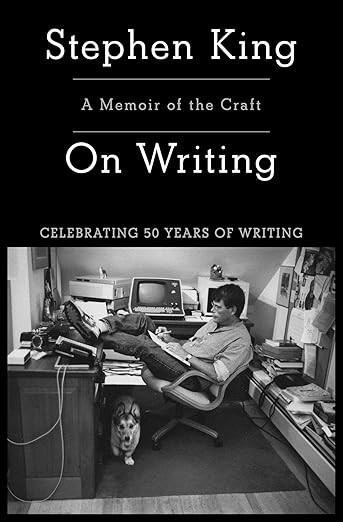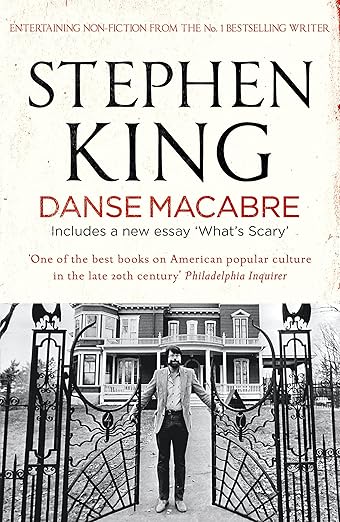

Must-Reads for Crafting Terrifying Tales
If you’re an aspiring horror writer—or a seasoned storyteller looking to sharpen your craft—reading widely in the genre is one of the best ways to hone your skills. Whether you’re mastering atmosphere, suspense, or psychological dread, these books will both inspire and educate you.
Each recommendation includes an Amazon affiliate link, so if you decide to grab a copy, you’ll be supporting my work as well!

Front Cover

Back Cover
Overview: This part-memoir, part-writing guide is a goldmine for horror writers. Stephen King doesn’t just teach you how to write—he teaches you how to be a writer. His insights on discipline, character development, and storytelling are invaluable.
What I Learned: King’s breakdown of the “toolbox” concept—where he explains that writing is a craft built on layers like vocabulary, grammar, and storytelling—stuck with me. His philosophy on writing without fear of failure made me reconsider my approach to storytelling.
Personal Take: When I was struggling with imposter syndrome, King’s words reminded me that every writer starts somewhere. He encourages writers to stop overthinking and just get the words down, a mindset that’s helped me push through drafts that might have otherwise stalled.

Overview: This is King’s love letter to the horror genre. He examines the cultural significance of horror in books, films, and television, breaking down what truly frightens people and why.
What I Learned: The biggest takeaway from this book was how horror reflects societal fears. King argues that horror isn’t just about monsters—it’s about what those monsters represent. Reading this helped me approach my own horror stories with deeper thematic intent.
Personal Take: This book made me think differently about the antagonists in my own stories. It encouraged me to look beyond surface-level scares and instead explore the psychological and existential fears that make horror truly unsettling.

Front Cover

Back Cover
Overview: Unlike other general writing guides, this book focuses specifically on horror fiction. Waggoner explores what makes horror work, including the psychology of fear, world-building, and unique horror structures.
What I Learned: One of the most eye-opening sections was about "The Rules of Fear"—understanding that horror works best when the reader is fully immersed in the dread. Waggoner also emphasizes that horror isn’t just about scares, but about confronting deep, personal truths.
Personal Take: I often struggled with making my horror scenes feel viscerally real, but Waggoner’s techniques on sensory immersion changed the way I approach horror writing. The section on crafting inescapable dread has directly influenced how I build tension in my stories.

Overview: This anthology-style book is a deep dive into horror storytelling, featuring insights from some of the biggest names in the genre, including Stephen Graham Jones, Clive Barker, and Ramsey Campbell. It covers everything from crafting fear-inducing narratives to the business side of horror publishing.
What I Learned: One of the most valuable sections of this book is its focus on how horror works at a psychological level. Many of the contributors discuss how fear isn’t just about monsters or gore—it’s about emotion, tension, and what lingers in the mind after the last page.
Personal Take: Before reading this, I focused mainly on external horror elements—the eerie settings, the terrifying creatures. This book pushed me to dig deeper into what truly unsettles readers on a personal and emotional level. It helped me realize that horror is most effective when it taps into real fears, like loss, isolation, or existential dread.

Overview: While not horror-specific, this book is an essential guide to story structure. It provides a detailed breakdown of successful narrative beats that can be applied to any genre.
What I Learned: The biggest game-changer was the concept of the "Save the Cat" moment—where your protagonist does something that makes the reader root for them. This has helped me write more compelling horror protagonists that readers connect with before the horror unfolds.
Personal Take: I used to struggle with pacing in horror, but Brody’s method of structuring a novel has given me a better framework to ensure my horror stories build suspense in a more natural, satisfying way.
Reading great horror fiction—and learning from the best—can elevate your own writing. Whether you’re fine-tuning your style, learning about psychological fear, or exploring different horror subgenres, these books provide the tools you need to craft truly terrifying stories.
Which of these books have you read? What are your go-to horror writing guides? Let me know in the comments!
Subscribe to my newsletter for exclusive writing advice, book recommendations, and horror industry insights.
Jamie Bucuy is a psychological horror and thriller writer with a Master of Fine Arts in Creative Writing. With a passion for exploring the darker facets of human nature, Jamie brings a keen analytical eye to the genre. His reviews combine literary insight with a deep understanding of the craft, providing readers with thoughtful perspectives on modern and classic horror fiction.
Stay updated with the latest news and releases from Jamie Bucuy